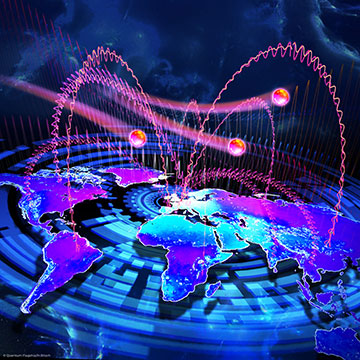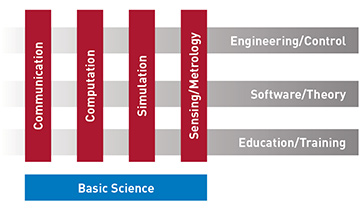
[Image: BKA/Christopher Dunker]
At a kickoff event in Vienna, Austria, on 29 and 30 October, the European Commission’s ten-year, €1 billion Quantum Flagship initiative formally launched, with the announcement of the first 20 research grants funded by the program. The 20 projects, developed by a range of international research consortia, will rake in a total of €132 million in Flagship funding over the next three years, in what’s being billed as the initiative’s “ramp-up” phase.
Bottom-up effort
The Quantum Flagship is one of three Future and Emerging Technology (FET) Flagships under the aegis of the European Union’s Horizon 2020 research framework program. (The two other Flagships, covering graphene technology and brain research, kicked off in 2013.) These programs explicitly take aim at addressing “grand challenges” in emerging science and technology. Each flagship has a term of around 10 years and a budget of around €1 billion across that term, half of it to come from the E.C. and half of it from member-state, industry and other sources.
The selection of quantum science and technology for the third Flagship, and the development of its scientific themes, was the result of a strong bottom-up effort, premised on input from a variety of stakeholders across European quantum science and industry (see “EuroQuantum,” OPN, September 2018). The result is a program explicitly built on four quantum applications research tracks, or “pillars”—communication, computation, simulation and sensing/metrology—undergirded by a cross-cutting foundation of basic science.

Strategic research structure of the Quantum Flagship. [Source: European Commission]
While the Quantum Flagship was officially announced some two years ago, the selection of the first projects for funding was not completed until this past June, and details on the winners has been under wraps until now.
One source of many
Impressive as the billion-euro price tag for the initiative sounds, it constitutes only one source of European funding for quantum research. Several member states have ambitious funding programs of their own. Among those is the U.K. (which is slated to leave the European Union in March), which has seen government commitments toward quantum research of some £400 million (~€450 million) between 2013 and 2018. Germany announced in September the addition of €650 million to its government research funding for quantum science and technology through 2022. And other European governments are pushing their own quantum programs, often targeted at niche areas.
Worldwide, meanwhile, other countries and regions are beefing up their own support of quantum research, in amounts that also somewhat deflate impact of the Quantum Flagship number. The U.S. Congress may soon enact a National Quantum Initiative with a targeted budget of nearly US$1.3 billion (€1.15 billion). And China is said to be spending billions of dollars on its own programs in quantum communications and computation.
Nonetheless, many European researchers view the Flagship as a positive step to stimulate continent-wide collaboration, and to put a European marker on the table in the international drive to move quantum from the lab to commercial applications. Tommaso Calarco of the University of Ulm, a central figure in building the Quantum Flagship, told OPN in summer 2018 that the purpose of it and the other FET Flagships is to “fill the gap between research and innovation” and to facilitate “translation from the lab to the market.”
“Basic science” feeds applications
The 20 programs ultimately selected for first-round funding were culled down from 140 proposals—a full 90 of which were aimed at the program’s “basic science” track. Of those 90 basic-science projects, seven were ultimately selected. While labeled basic science, most of those selected programs have a distinctly applied flavor, and are pitched to make progress on components for specific applications in computing, communications or sensing, or that cut across those applications.
Two of the chosen basic-science projects, for example—the 2D-SIPC project, coordinated by Spain’s ICFO, and S2QUIP, managed by Sweden’s Kungliga Tekniska Hoegskolan—will attempt to leverage graphene and other 2-D materials to engineer single-photon optoelectronic devices and quantum light sources that can be used in a variety of quantum applications, including photonic integrated circuits. Other basic-science programs will work on improving microwave ion traps, developing compact quantum light sources, and refining other techniques or components to feed applied technology efforts in quantum.
Computing and simulation

[Image: BKA/Christopher Dunker]
The computing and simulation tracks, meanwhile, each will feature two initially funded projects that aim at grander, system-scale goals. One computing-track project, AQTION (Advanced quantum computing with trapped ions), coordinated by the Universität Innsbruck, Austria, aims at realizing “a fully automated ion-trap quantum computer to solve scientific and commercially interesting problems beyond the capabilities of classical computers.” Another, OpenSuperQ, managed by Universität des Saarlands, Germany, plans to build a 100-qubit superconducting quantum computer “that would be open to the community”—perhaps an answer to IBM’s Q Experience.
For quantum simulation, meanwhile—which has recently seen advances in simulating physical systems on several platforms—the initial Flagship will fund projects to push forward neutral-atom and ion-based simulators, and to create simulator platforms that can serve in the development of “a new generation of quantum cascade laser frequency combs.”
Communications and sensing
Communications fared particularly well in the first Flagship round, with four of eleven submitted proposal chosen for funding. One particularly high-profile winner is the Quantum Internet Alliance, a group spearheaded by the Technische Universiteit Delft, that is working to create an end-to-end full-stack demonstration of a quantum internet. Other funded communications projects take aim at more niche targets, including improvements to quantum key distribution for secure communications; better, cheaper and more secure quantum random-number generators; and efforts to achieve on-chip implementations of quantum communications applications.
Finally, in the area of sensing and metrology, the initial Flagship round will fund four projects. Two will leverage diamond color centers (such as nitrogen-vacancy centers) to build new sensors for cardiovascular disease and for industrial applications. A third will work to develop “novel and compact atomic clocks” using optical technology, for use in telecom, global navigation and fundamental physics. And a fourth will attempt to combine quantum sensors and MEMS atomic vapor cells to develop ultrasensitive industrial instruments.
A complete list of the 20 funded projects can be found in the Quantum Flagship press release at https://qt.eu/news/quantum-technologies-launch-press-release/.
